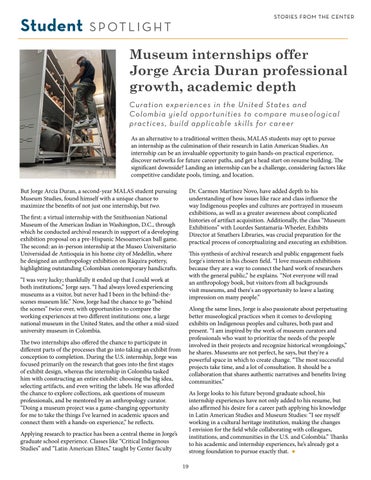STORIES FROM THE CENTER
Student S P O T L I G H T
Museum internships offer Jorge Arcia Duran professional growth, academic depth Curation experiences in the United States and Colombia yield opportunities to compare museological practices, build applicable skills for career As an alternative to a traditional written thesis, MALAS students may opt to pursue an internship as the culmination of their research in Latin American Studies. An internship can be an invaluable opportunity to gain hands-on practical experience, discover networks for future career paths, and get a head start on resume building. The significant downside? Landing an internship can be a challenge, considering factors like competitive candidate pools, timing, and location. But Jorge Arcia Duran, a second-year MALAS student pursuing Museum Studies, found himself with a unique chance to maximize the benefits of not just one internship, but two.
Dr. Carmen Martínez Novo, have added depth to his understanding of how issues like race and class influence the way Indigenous peoples and cultures are portrayed in museum exhibitions, as well as a greater awareness about complicated histories of artifact acquisition. Additionally, the class “Museum Exhibitions” with Lourdes Santamaría-Wheeler, Exhibits Director at Smathers Libraries, was crucial preparation for the practical process of conceptualizing and executing an exhibition.
The first: a virtual internship with the Smithsonian National Museum of the American Indian in Washington, D.C., through which he conducted archival research in support of a developing exhibition proposal on a pre-Hispanic Mesoamerican ball game. The second: an in-person internship at the Museo Universitario Universidad de Antioquia in his home city of Medellín, where he designed an anthropology exhibition on Ráquira pottery, highlighting outstanding Colombian contemporary handicrafts.
This synthesis of archival research and public engagement fuels Jorge's interest in his chosen field. “I love museum exhibitions because they are a way to connect the hard work of researchers with the general public,” he explains. “Not everyone will read an anthropology book, but visitors from all backgrounds visit museums, and there's an opportunity to leave a lasting impression on many people.”
“I was very lucky; thankfully it ended up that I could work at both institutions,” Jorge says. “I had always loved experiencing museums as a visitor, but never had I been in the behind-thescenes museum life.” Now, Jorge had the chance to go “behind the scenes” twice over, with opportunities to compare the working experiences at two different institutions: one, a large national museum in the United States, and the other a mid-sized university museum in Colombia.
Along the same lines, Jorge is also passionate about perpetuating better museological practices when it comes to developing exhibits on Indigenous peoples and cultures, both past and present. “I am inspired by the work of museum curators and professionals who want to prioritize the needs of the people involved in their projects and recognize historical wrongdoings,” he shares. Museums are not perfect, he says, but they're a powerful space in which to create change. “The most successful projects take time, and a lot of consultation. It should be a collaboration that shares authentic narratives and benefits living communities.”
The two internships also offered the chance to participate in different parts of the processes that go into taking an exhibit from conception to completion. During the U.S. internship, Jorge was focused primarily on the research that goes into the first stages of exhibit design, whereas the internship in Colombia tasked him with constructing an entire exhibit: choosing the big idea, selecting artifacts, and even writing the labels. He was afforded the chance to explore collections, ask questions of museum professionals, and be mentored by an anthropology curator. “Doing a museum project was a game-changing opportunity for me to take the things I've learned in academic spaces and connect them with a hands-on experience,” he reflects.
As Jorge looks to his future beyond graduate school, his internship experiences have not only added to his resume, but also affirmed his desire for a career path applying his knowledge in Latin American Studies and Museum Studies: “I see myself working in a cultural heritage institution, making the changes I envision for the field while collaborating with colleagues, institutions, and communities in the U.S. and Colombia.” Thanks to his academic and internship experiences, he’s already got a strong foundation to pursue exactly that. ◆
Applying research to practice has been a central theme in Jorge’s graduate school experience. Classes like “Critical Indigenous Studies” and “Latin American Elites,” taught by Center faculty 19










